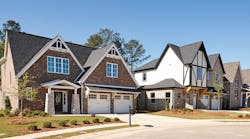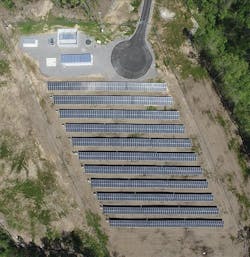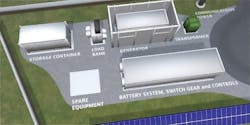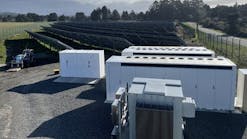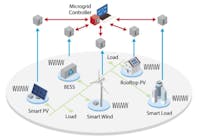As the energy industry continues to evolve, accelerating the development of technology is more important than ever. By leading the industry in research and development (R&D) and partnering with world-class researchers, technology vendors and builders, Southern Company strives to be a part of revolutionizing the future of energy and advancing the industry’s understanding of how to make buildings-to-grid communication a reality.
Innovative buildings-to-grid and distributed energy R&D will enable Southern Company to recognize the opportunities these interactions create for the grid as well as the challenges that surface when interfacing with consumer devices. These types of projects are beginning to develop across the industry, and the results will help energy companies meet customers’ changing needs while increasing the overall resiliency and flexibility of the grid.
Southern Company and its Alabama Power and Georgia Power subsidiaries are conducting Smart Neighborhood projects to proactively simulate what the future could hold for them and their customers. In a future potentially filled with distributed energy resources (DERs) and microgrids, initiatives like this will enable Southern Company to adapt and continue providing clean, safe, reliable and affordable energy to its customers and communities.
The Smart Research Project
The Smart Neighborhood project consists of two efforts—one in a suburb of Birmingham, Alabama, U.S., and the other in Atlanta, Georgia, U.S.—that explore unique approaches to microgrid configuration and management. Both locations have three technology pillars for exploring different solutions:
1. High-performance homes—Both neighborhoods include high-efficiency construction techniques, aiming for a Home Energy Rating System (HERS) score between 40 and 50. This is to represent how typical residential construction might look 20 years from now. Features considered by HERS include insulation in the exterior walls and ceiling; water heating and heating, ventilation, and air conditioning (HVAC) systems; and building envelope to reduce air leakage and optimize thermal distribution. The HERS score for these homes was improved using advanced features—such as heat pump water heaters, variable capacity HVAC systems and insulations—that exceed current construction codes.
2. DERs—Solar panels, natural gas generators and batteries are deployed in two unique configurations. In the first configuration, assets are grouped into a community-scale generating station that can power the community in grid-connected or islanded mode. The second configuration looks at a series of individual home-based renewable generation and battery energy storage technologies. Both scenarios will help Southern Company to develop new strategies for integrating DERs seamlessly into real-time grid operations.
3. Buildings-to-grid communication—The two largest users of energy in homes in the Southern United States, the water heater and HVAC systems are internet-connected and can interact with the grid to manage and shift energy consumption while maintaining customer comfort. This approach leverages the inherent flexibility and thermal-energy storage capability of these two end-use devices, serving as additional assets in both grid-connected and islanded operation.
Alabama’s Smart Neighborhood
Alabama Power’s Smart Neighborhood includes 62 single-family homes and a nearby community-scale microgrid, consisting of solar panels, battery energy storage and a natural gas generator. The neighborhood receives energy from both the microgrid and the existing electric grid. One research objective is to evaluate how this combination of DERs and a hyperefficient neighborhood could enable the grid to better serve customers.
Both the homes and DERs use energy management software tools developed by the U.S. Department of Energy’s Oak Ridge National Laboratory (ORNL). One tool communicates with each home’s water heater and HVAC systems, while the other focuses on developing and testing microgrid control algorithms to help manage distributed generation assets. Together, these software tools interact to implement different microgrid use cases.
The project features an electrical network that has a typical distribution feeder directly connected to the neighborhood. On the other side of the neighborhood circuit, the microgrid generation and energy storage assets are connected, creating an electrical sandwich with the neighborhood in the middle. The neighborhood subdivision is located about 1 mile (1.6 km) from the actual microgrid DER asset location.
During the planning, implementation and operational phases of the microgrid, the project team worked closely with the company’s distribution planning, field engineers and the distribution control center to establish a way for the Alabama Power distribution operations team to interact with the microgrid. Currently, the Southern Company research team is responsible for operating the microgrid and implementing new control algorithms to perform ongoing tests. However, during islanding and resynchronization tests, researchers work closely with distribution to coordinate higher-risk tests.
Timing and Testing
Construction of the community-scale microgrid, known as the Shannon-Oxmoor microgrid, was completed in December 2017 by Southern Company subsidiary PowerSecure, and it has been supplying energy to the grid since January 2018. The site features three DER technologies, including a 360-kW natural gas generator, 330-kWAC photovoltaic (PV) solar array and 300-kW/680-kWh lithium-ion battery system.
The microgrid can be put in island mode, which means these generation assets can supply power directly to the Smart Neighborhood and become isolated from the grid. Additionally, the microgrid can island without the neighborhood load by using a 400-kW resistive load bank on the site. This testing configuration enables researchers to demonstrate software updates without the risk of causing a power outage to the neighborhood.
Commissioning tests for the DER assets and microgrid controller were initially conducted using the load bank to avoid risking interruption of customers’ service. These tests demonstrate operation of the system in various modes and combinations to assure that it all worked correctly. This process enabled researchers to identify and define operational boundaries within the controller to ensure microgrid stability.
After validating the controller and DER functionality with the load bank, the project progressed to testing the microgrid with the 62-home community. The microgrid and homes were islanded successfully from the grid several times, sometimes multiple times in one day, to prove the microgrid controller could manage the dynamic load effectively in the homes by changing the DER output. These tests also validated that the neighborhood could be islanded seamlessly. Operational tests performed with the microgrid to date include islanding and resynchronization, black start, unintentional islanding, fault stability and ride through, economic dispatch and PV smoothing.
The microgrid controller developed by ORNL had to be tested and adapted to this particular field installation. Several iterations and tweaks in coding were required before the software was implemented to operate the microgrid autonomously. The controller continues to be improved and updated to operate in a more robust, resilient way.
The autonomous testing phase has recently begun, in which an economic dispatch algorithm was implemented. The controller continuously optimizes DER dispatch by using weather data, fuel pricing and load forecasts to operate the microgrid in the most economical manner. Deployment of the controller in this mode means there is no human intervention in manual dispatch or curtailment of the natural gas generator, battery or PV. Additional testing has demonstrated the battery system’s ability to smooth the PV output significantly throughout the day to minimize the impact of high ramping of power production.
Increased Reliability
During the Alabama Power implementation, the microgrid has proven its potential to increase customer reliability. Recently, a voltage fluctuation on the local distribution grid caused the microgrid system to react and island from an unanticipated grid disturbance. The system performed as expected, and the customers remained online through the disturbance and were seamlessly reconnected to the grid once the issue was resolved.
Although this proves microgrid technologies can be a useful tool to increase reliability, researchers also have learned development is still needed to harden the technology. An unintentional islanding event recently occurred because of an error in the controller algorithm, but the microgrid proved to be resilient as customers did not notice the event. The team is working to simulate the error and develop a solution to this bug.
Bright Future
Future tests for the microgrid also include volt-volt-ampere-reactive (volt-VAR) regulation, inclusion of the dispatchable residential loads (HVAC and water heater), effectiveness at maintaining zero power flow across the point of common coupling, net-zero energy, long-duration islanding and transactive energy trials. Southern Company continues to identify and test specific microgrid use cases to understand the real added value of these systems for customers and the broader electrical grid. A large collaborative effort among ORNL, the Electric Power Research Institute (EPRI) and Southern Company is underway to identify and develop use cases and methodologies to assess the technical and economic feasibility of microgrids. As performance metrics are defined and tests are executed, the data collected will provide results that will be used to perform cost-benefit analyses. By working in the buildings-to-grid space with projects such as Smart Neighborhood, Southern Company is leading technology change and meeting customers’ energy needs today while building America’s energy future.
Sidebar: Georgia Power’s Smart Neighborhood
In the beginning stages of construction, the Georgia Power Smart Neighborhood will consist of 46 townhomes—each with rooftop solar panels and a behind-the-meter in-home battery energy storage system. This community will use a software tool developed by the U.S. Department of Energy’s Oak Ridge National Laboratory (ORNL), similar to those used in Alabama Power’s Smart Neighborhood, to manage distributed energy resources (DERs) and end-use devices, like the water heater, at the home level as well as implement predictive controls. This will maximize value for homeowners and the grid.
Additionally, the energy management software tool will enable Southern Company to gain a better understanding of how the townhomes can be aggregated and managed to provide valuable grid resources. Completion of the Georgia Power Smart Neighborhood is anticipated in 2019.
Editor’s Note: This article is from a presentation at the Electric Power Research Institute’s Electrification 2018 International Conference & Exposition held in Long Beach, California, U.S.
Jim Leverette ([email protected]) evaluates residential and commercial HVAC, water heating, automation and building envelope systems at Southern Company As the technical lead for Alabama Power’s Smart Neighborhood, he has managed the overall design and deployment of the project. Prior to joining Southern Company, Leverette’s work focused on field energy-efficiency audits, data logging, engineering and economic analyses for building energy systems. He holds BSME and MSME degrees from Tennessee Tech University.
Kim Nguyen ([email protected]) specializes in distributed and renewable energy technology evaluations, including combustion-based generators, fuel cells and other customer-sited distributed energy innovations. She is a technical resource for design and implementation of microgrid R&D deployments. Previously, Nguyen supported wind and solar energy resource assessments as well as renewable technology studies in lab and field evaluations. She holds a BSME degree from the University of Alabama at Birmingham.
Andrew Ingram ([email protected]) focuses on research related to the integration and impact of grid-edge technologies at Southern Company Examples of grid integration research include energy storage, renewable generation and power electronic devices. Prior to joining the research and development group, Ingram worked in Southern Company’s transmission planning group, where he completed strategic analysis studies of the entire Southern Company transmission system. Ingram holds a BSEE degree and bachelor’s degree in psychology from the University of Alabama.
For more information:
EPRI | www.epri.com
Southern Company | www.southerncompany.com
U.S. Department of Energy’s Building Technology Office
https://www.energy.gov/eere/buildings/building-technologies-office
